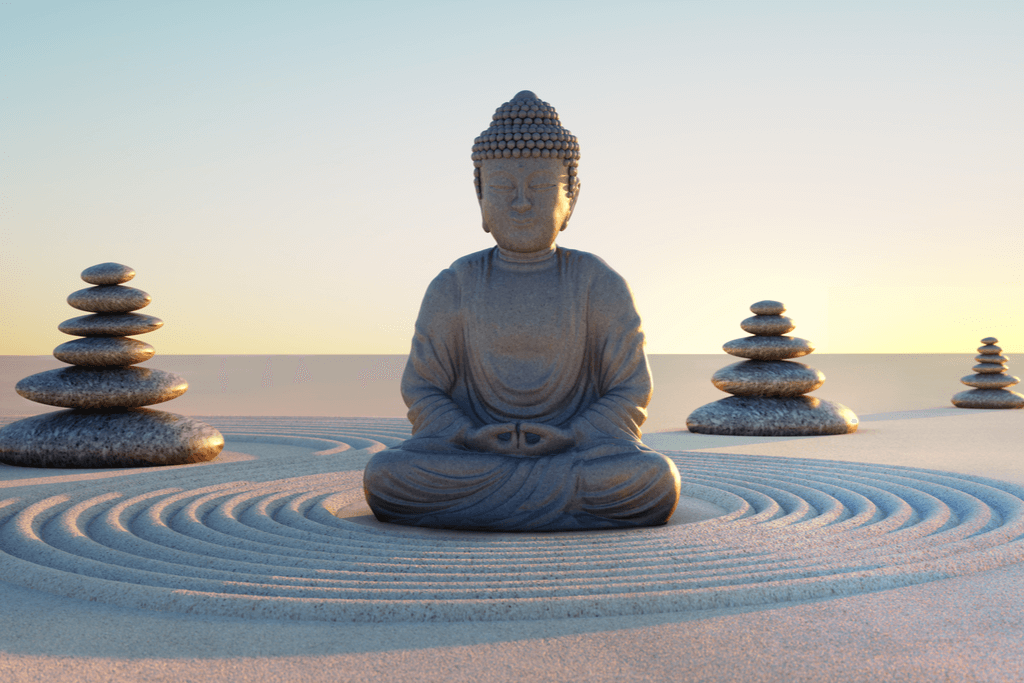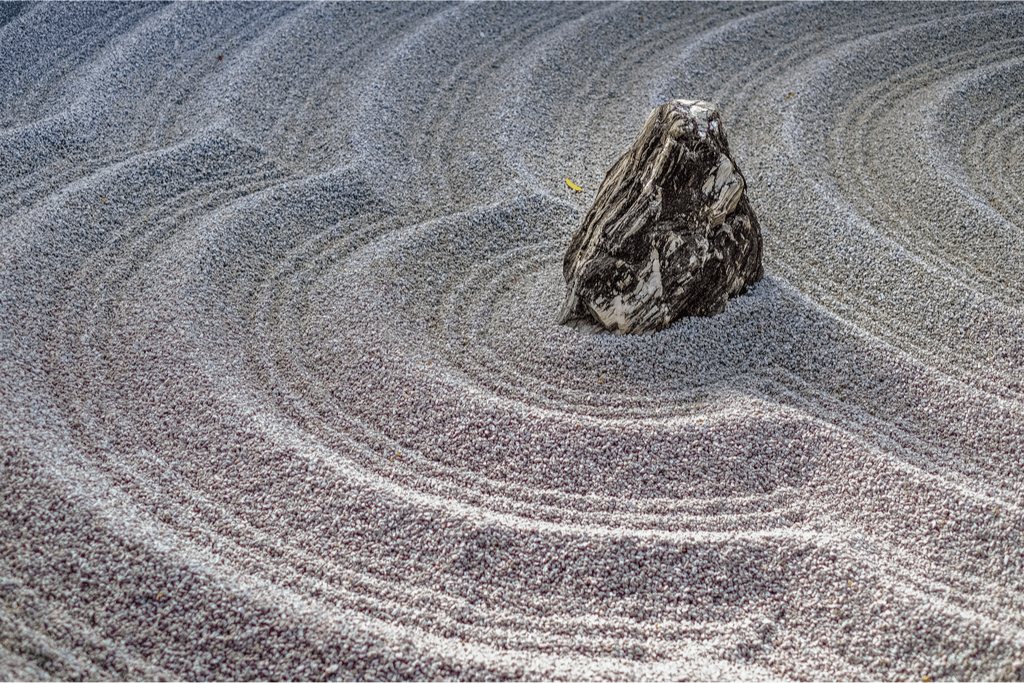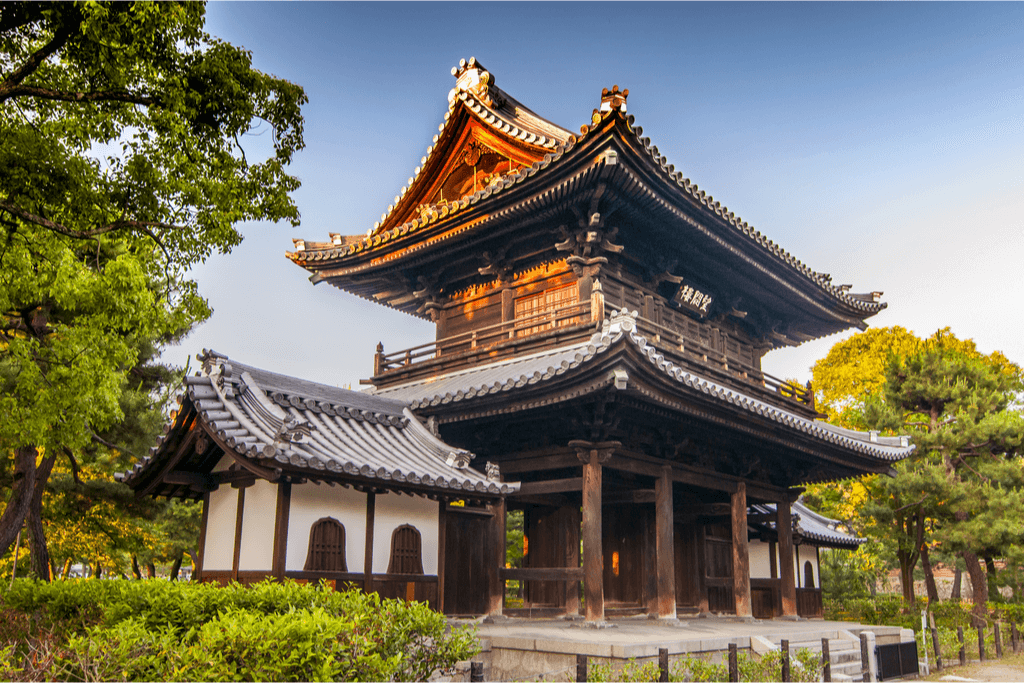buddhism, culture, japanese rock gardens, rock garden
Japanese Rock Gardens Can Make You Find Zen
Bianca Bache
Posted on September 26, 2022
Share:

Japanese rock gardens are an important staple of Buddhist culture. Buddhism, particularly Zen Buddhism, is a major influence in modern day Japan. Temples, shrines and meditation play a special role in the nation’s culture and history. During the 6th Century when Buddhism was spreading in Japan, many Zen Buddhist temples were built to house the newer followers.
To accompany these temples and to aid meditation, Zen gardens were constructed. The gardens were used as a space to elicit reflections and encourage deep thoughts on Buddha teachings. To inspire contemplation and meditation, Zen rock gardens were typically designed to be minimal spaces devoid of distractions.
What are Japanese Rock Gardens Made Of?
Zen rock gardens are also known as karesansui in Japanese, translates to “dry landscape garden.” Zen gardens hold mass popularity in Japan and are enjoyed for their simplicity and tranquility.

In traditional Japanese rock gardens, white sand, rocks and moss are the main components used. These three elements are used to represent other elements of nature such as water, islands, mountains, trees, animals and fire. More often the white sand is used to represent water and water features such as ponds. The sand is also used to provide negative space to compliment the other elements in the rock garden.
Dry Water Features
White sand and gravel are meticulously and carefully raked each day by monks as a form of meditation. The sand and the raked gravel represent the flow of water. Each intricate design is crafted to fit within the elements that are in the rest of the rock garden. To further emphasize the dry water feature in the garden, wooden and stone bridges are placed over or near these areas.

Looking to experience even more authentic and traditional Japan? Then try Sakuraco! Sakuraco send authentic Japanese tea, sweets and snacks, right to your door.
All Kinds of Rocks
When choosing rocks for rock gardens you can’t use any you find lying around. There is a specific method behind the shape, size, age and quality of the rock that is chosen. Choosing the correct rock and placement within the garden with the other elements can take years to fully master. In Japanese culture it is thought that if there is improper elemental and rock arrangement it could lead to bad luck.

In order to avoid bad luck, understanding the placement of all the elements is important. Vertical rocks represent mountains and horizontal rocks symbolize islands or earth. Often rough and worn rocks are preferred to symbolize a mountain landscape. While smoother rocks are used as stepping stones around dry water.
Rocks and other elements are usually arranged asymmetrical to create a spontaneous look that mirrors nature. Using odd-numbered groupings of varying height and sizes at random is key to mastering this unique Japanese style. As the garden ages over time, rocks will take on more of a weathered appearance which adds to the beauty of the landscape.
Rock Gardens in Japan
In Japan you may find smaller Zen rock gardens where homeowners can appreciate quiet moments in their home. If you would like to take a moment to enjoy Japanese gardens, there are some open to the public that locals and tourists can visit. Although originally attached to Zen temples and temple complexes these gardens can be found in many places. With the most notable gardens in Kyoto.

In Japan the first rock garden was built in 1251 in Kanagawa, in the city of Kamakura, which the nation’s capital at the time. Because of this, it was the first location to build gardens that resembled Chinese landscapes. During the years 1336 to 1573 however, the capital moved to Kyoto and the building of shrines and Zen gardens went along with them.

Zen Gardens in Kyoto
Kyoto is mostly known for its historical temples and spring sakura trees (cherry blossoms), but Kyoto has a lot more to offer when it comes to traditional rock gardens. The gardens are often etched with abstract hidden Zen dialogues or are depicting famous scenes from Japanese history.

There are numerous places in Kyoto where you can enjoy the rock gardens for yourself. One of them is Ryoan-ji Temple, a World Heritage site which is also one of the most visited temples in Japan. Another one is the Kennin-Ji Temple which is south of Kyoto’s central Gion District and boasts being one of Kyoto’s oldest Zen temples. Finally, there is the Tofuku-Ji Temple which was designed by renowned designer and landscape architect Mirei Shigemori. The gardens were built in 1939 and combine the Zen aesthetic with modern art.
Zen rock gardens are a simple, yet wonderful sight to behold. They hold a place in many people’s hearts and collective history. Have you ever been to a rock garden before? Would you ever keep on in your home? Let us know in the comments below.

Discover authentic flavors with Sakuraco
Get Sakuraco 

Discover authentic flavors with Sakuraco
Get Sakuraco 
Related Articles

Mount Fuji Snacks That You Need to Try This Summer!
Mount Fuji, Japan’s highest and most iconic peak, has long served as a muse not just for artists and poets, but also for confectioners. Its symmetry and snow-capped grandeur make it an ideal motif for culinary artisans nationwide. These treats capture the spirit of Fuji in edible form, reflecting regional ingredients, seasonal symbolism, and time-honored techniques.

Okinawa City is Home to Southeast Botanical Gardens!
The Southeast Botanical Gardens in Okinawa are one of the island’s most beautiful and relaxing destinations. In Okinawa City, they offer a lush escape filled with tropical plants, ponds, animals, and seasonal displays.

Mount Fuji Tour: Great Adventures Await You This Summer!
Mount Fuji is one of the most famous landmarks in Japan. People worldwide visit to see its beauty and enjoy exciting yearly outdoor activities!

Mikoshi: Why Are These Portable Shrines So Important?
Japan’s summer festivals are known for their energy, color, and tradition. And at the heart of many lies the mikoshi.



